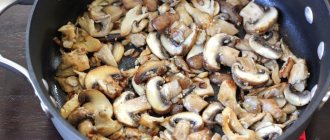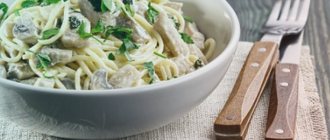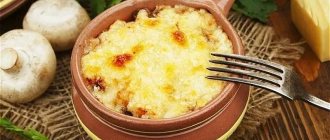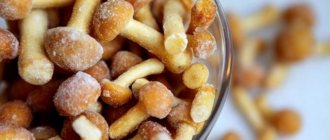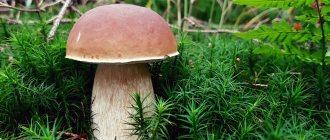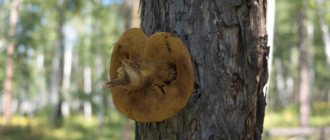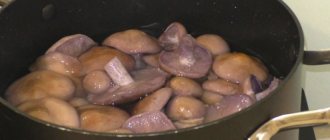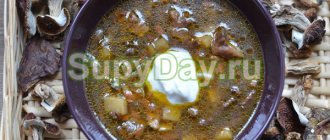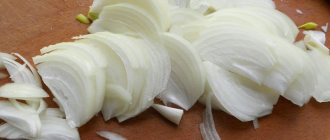Picking mushrooms is not only an exciting activity, but also a very responsible one. After all, by putting anything into a basket, you can poison yourself and endanger your loved ones. Inexperienced mushroom pickers, having studied what fly agaric and toadstool look like, think that this is enough to protect themselves from the poison growing in the forest. And having brought home a basket (or even two full buckets), these gatherers are already looking forward to a delicious meal. But in the end, you can’t take a single spoon into your mouth because of the acrid taste. Let's look at the reasons why mushrooms are bitter.
What does it mean if champignons are bitter?
The most likely reason is the presence of poisonous counterparts in the prepared dish. They can be very beautiful to look at, with no sign of snails or worms. But just one such mushroom can spoil an entire dish with bitterness. Another reason may be poor environment.
Interesting materials:
How to wash and dry wool socks? How to wash Iziki in a machine? How to wash Lacoste sneakers? How to wash natural silk in a machine? How to wash polyurethane pillows? How to wash with oxygen bleach? How to wash Lassie snowsuit? How do grasshoppers chirp? How do crickets chirp? How to cut crop?
Processing before cooking
Before use, be sure to thoroughly clean and wash the mushrooms.
Through experimentation, we found out that it is better not to wash the champignons too thoroughly and not to peel their top layer, since all the taste of these mushrooms is concentrated in the surface layer.
In order to get rid of excess mucus from boletus and boletus mushrooms, before cooking, cut off their spongy part, which is located under the mushroom cap. Moreover, our body has a very difficult time digesting this sponge.
The skin must also be removed from the butter, as after cooking it becomes slippery and unpleasant. It is better to cut these mushrooms in half during the cleaning process to ensure that the mushrooms are not wormy. It is not recommended to soak them, as this will cause them to lose their great taste.
Let's clarify some facts
To avoid mushroom poisoning, you need to know as much as possible about them. Therefore, we will try to clarify some facts about poisonous and edible mushrooms.
It is believed that poisonous mushrooms must be bitter, ugly and have an unpleasant odor. This is wrong. For example, such dangerous mushrooms as panther fly agaric, toadstool or poisonous roseate have neither taste nor particular smell. And false mushrooms cannot be distinguished from real ones by appearance.
Insects and snails also eat poisonous mushrooms; mushroom pickers often find pale toadstools on which snails sit.
You can be poisoned not only by poisonous mushrooms, but also by edible ones, if they are already old, spoiled and poorly processed.
When poisoning with mushrooms, the following symptoms appear: nausea, abdominal pain, diarrhea, vomiting, weakness, and agitation. If they appear, you need to call an ambulance, but in the meantime, do a gastric lavage with water and potassium permanganate and a cleansing enema. Drink salted water.
Collection and processing
There are 2 reasons for the appearance of bitterness in mushrooms:
- Failure to comply with collection rules. Chanterelles become bitter after being collected in dry weather if they are collected near roads or industrial zones. In addition, chanterelles, which grow surrounded by moss and coniferous trees, are susceptible to this.
- Failure to comply with the rules of preparation for further storage. To eliminate bitterness you need:
- clean the chanterelles from debris, cut out rotten and injured areas;
- rinse them under running water several times;
- pour saline solution for 1 hour (1 tsp per 1 liter of water);
- then drain the water and dry the product.
All these procedures are carried out immediately after collecting mushrooms, otherwise they will become saturated with toxic substances and will taste bitter.
Due to inexperience, many mushroom pickers confuse real chanterelles with false ones, which contain a bitter aftertaste. Real mushrooms have a rich yellow cap, while false mushrooms have an orange cap.
Irina Selyutina (Biologist):
Signs of false chanterelles (orange talkers)
- Habitat: coniferous and mixed forests (deadwood, old fallen trees, forest litter, moss).
- They grow in groups or singly, reaching a maximum in late summer and autumn.
- Cap color: bright orange or orange with a brown tint, lighter along the edge than in the center.
- The surface of the cap: velvety to the touch and to the eye.
- The edges of the cap: even and smooth, neatly rounded.
- Cap diameter: 3-6 cm.
- The shape of the cap: in older specimens it is funnel-shaped, in young specimens it is slightly convex.
- Hymenophore plates: thin, frequent, branching, orange, descend to the stalk, but do not pass onto it.
- Pulp: yellow, with an unpleasant odor, tasteless, loose. When pressed, the color does not change.
- Stipe: thin, hollow in adult specimens, clearly demarcated from the cap.
The bitter taste of false chanterelles quickly transfers to good mushrooms.
We eat raw
Raw mushrooms can be colorful and delicious. Champignons, oyster mushrooms, truffles, saffron milk caps and porcini mushrooms have an interesting taste, aroma and texture. Saffron milk caps are probably the only milk mushrooms that can be eaten raw. Ryzhiki can be prepared using the carpaccio method, seasoned with sweet and sour sauce and giving a slight note of piquancy.
Only the cap of a porcini mushroom in its raw form is edible; the main thing is to check it for the presence of worms. The most delicious porcini mushroom is the young one, the cap of which has not yet opened.
Truffles have a distinct taste, with a taste of well-roasted seeds or walnuts, and a strong aroma. If the truffle is placed in water and kept in it for some time, it acquires the taste of soy sauce. Oyster mushrooms are easily digestible. Only the caps are used for food, since the legs of oyster mushrooms are hard. True, the aroma of these mushrooms is rather weak.
How to remove bitterness from milk mushrooms without soaking
Soaking bitter milk mushrooms in water effectively helps remove the bad taste, but is a rather lengthy task. Many would like to somehow speed up the process and remove the bitterness from the mushroom pulp in a couple of hours.
Unfortunately, this cannot be done without any processing at all. The bitter taste depends on the presence of milky juice in the pulp, and the juice can only be removed with water.
But it is possible to remove the bitterness from white milk mushrooms without soaking for several days; an alternative is to quickly boil the fruiting bodies in salted water:
- During cooking, the milky juice leaves the mushroom pulp in the same way, only it can be removed faster than when soaking.
- To effectively remove the bitter taste, you need to boil the mushroom bodies with salt for 10 minutes, then drain the water and replace it with fresh water, and then put the mushrooms back on the stove for the same time.
- In total, the procedure is repeated 3 times, each time changing the water in the pan and not forgetting to salt it. When following the rules, the fruiting bodies lose their unpleasant taste and at the same time retain the white color of the pulp.
- When cooking, you must ensure that the water completely covers the fruiting bodies. If the caps protrude above the water, the bitterness may persist, since the processing will not affect the entire surface of the mushrooms.
The only drawback of this method is that boiled milk mushrooms are subsequently only suitable for frying, adding to soup or stewing. It is not customary to salt or pickle them, since boiled fruit bodies lose their pleasant elasticity and crispness.
Cooking eliminates unpleasant taste no less effectively
Important! To be safe, some mushroom pickers boil milk mushrooms three times for 30 minutes or more.
Practice shows that there is usually no need for boiling - it is possible to make milk mushrooms non-bitter much faster, and with prolonged heat treatment the fruiting bodies become too boiled.
Insidious doubles
Mother Nature, along with edible mushrooms, scattered their poisonous clones throughout the forest. These are, first of all, false honey mushrooms, boletus mushrooms, chanterelle mushrooms, champignons, boletus mushrooms and even boletus mushrooms, which are surprisingly similar to white mushrooms. Therefore, answer No. 1 to the question why mushrooms are bitter is this: along with the right gifts of the forest, you also picked up their poisonous counterparts. Even one such false honey fungus, squeezed into a basket, can spoil the entire dish with unbearable bile. I'll have to throw it all away, sadly. It is better to check the authenticity of the find on the spot. As a rule, false mushrooms are very beautiful: bright, untouched by worms and snails. In addition, you can touch the cut of the cap with the tip of your tongue. The deadly poisonous satanic mushroom looks like a white mushroom, but its Ukrainian name “gorchak” speaks for itself. In addition, it turns blue and red when cut.
Avoid vinegar
When preparing mushroom dishes, try to replace table vinegar, often called for in recipes, with light citrus or berry juice: lemon, orange, apple, currant, and so on. It's both tastier and healthier.
Mushroom season is in full swing. Five simple and budget-friendly chanterelle dishes Read more
Ecology
In the question “why are mushrooms bitter”, one cannot discount the conditions in which the fruiting bodies grew. Their spongy structure absorbs everything that is carried in the air, spilled in groundwater or lying in the ground. Champignons found in city public gardens have been sprinkled not only by summer rain, but also by numerous dogs, so their taste is distinctly urine. Mushrooms near roadsides are not only not tasty, but also dangerous to health. Even boletus contains heavy metals and poisons from exhaust gases.
Fickle chanterelles
Even experienced mushroom pickers, who know exactly what they put in the basket and how to cook it, sometimes end up with a completely inedible dish. What's the matter? After all, there are chanterelle mushrooms in the frying pan. Why do they taste bitter, although they were tasty when collected a week earlier in the same place? The answer is simple: climate. If there is not enough moisture, the juice inside the fruiting bodies becomes bile. Therefore, mushrooms collected in the summer heat taste bitter. The same applies to chanterelles found in moss in a spruce forest - the acrid taste of resin makes them practically inedible.
Collecting the right mushrooms
Many edible and conditionally edible mushrooms have poisonous analogues, or false mushrooms - false honey mushrooms, false chanterelles, boletus, champignons, and even false porcini mushrooms, considered royal.
It will not be possible to remove the bitterness from them even after long-term processing; moreover, in addition to the bitterness, they will also contain poisons that are dangerous to humans, so you need to collect only those mushrooms whose quality is beyond doubt.
For example, gall mushroom, or bitterling, is not edible, although in appearance it can easily be mistaken for boletus, boletus or porcini mushroom. Cooking bitters only enhances the bitterness.
Experienced mushroom pickers warn that even one poisonous and bitter mushroom can ruin the entire dish; its bitterness is enough for everyone. Therefore, it is better to check mushrooms in the forest. Poisonous analogues of edible mushrooms look brighter and more beautiful than non-poisonous ones. They are rarely eaten by worms, snails and insects, but that's not all - when cut, the poisonous mushroom turns blue, while its edible counterpart turns red.
Bitterness is noted in milk mushrooms - milk mushrooms, travelers, chanterelles, volnushki, podtopolniks, white mushrooms, valuevs and some other edible mushrooms.
Mushrooms collected in coniferous forests are more bitter than mushrooms from deciduous forests, even if they belong to the same species and family. In addition, “coniferous” mushrooms have a resinous aftertaste that is not so easy to remove.
Another reason for bitterness in edible mushrooms is lack of moisture. Immediately after rain, mushrooms are tasty, but after a week, due to the heat, their taste can change greatly for the worse. Due to lack of moisture, they become bitter or bilious.
Mushrooms will be bitter in polluted areas; everyone knows that they, like a sponge, absorb everything that is in the air, soil and water. You cannot even collect edible mushrooms growing along roads, near large industrial enterprises, landfills and other pollutants. You only need to cut mushrooms with a stainless steel knife or a ceramic knife.
Some mushrooms are naturally bitter!


